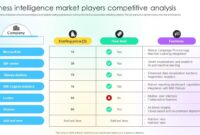The Role of BI Dashboards in Executive Decision Making presents an insightful exploration into how business intelligence tools transform executive strategies. In today’s fast-paced corporate landscape, decision-makers rely heavily on data-driven insights to steer their organizations towards success. BI dashboards serve as a pivotal resource, offering a visual representation of crucial metrics that inform strategic choices and enhance operational efficiency.
By consolidating vast amounts of data into an easily digestible format, these dashboards empower executives to make informed decisions swiftly. They facilitate real-time monitoring of key performance indicators, enabling leaders to identify trends, forecast outcomes, and adjust their strategies accordingly. As businesses continue to navigate complex environments, understanding the role of BI dashboards becomes essential for effective decision-making.
In today’s fast-paced world, the way we communicate is constantly evolving. From emails and texts to social media posts, the methods we use to share our thoughts and ideas are dynamic and diverse. But amidst this evolution, one thing remains constant: the need for effective communication. This article explores the nuances of casual formal language, providing insights into how to strike the perfect balance in various contexts.
### Understanding Casual Formal Language
Casual formal language is a unique blend of casual and formal communication styles. It retains the professionalism characteristic of formal language while incorporating some of the relaxed elements found in casual speech. This blend is particularly effective in professional settings where building rapport and maintaining professionalism are equally important.
Why Use Casual Formal Language?
1. Approachability: Casual formal language makes you seem more relatable and approachable. This is particularly crucial in environments where teamwork and collaboration are essential.
2. Clarity: While formal language can sometimes be dense and filled with jargon, casual formal language prioritizes clarity, making it easier for others to understand your message.
3. Engagement: A more relaxed tone can engage your audience better. This is particularly true in presentations or meetings where keeping the audience’s attention is vital.
4. Versatility: This style can be utilized in a variety of contexts, from emails to presentations, making it a versatile choice for professionals across industries.
### Guidelines for Effective Use
To effectively use casual formal language, consider the following guidelines:
1. Know Your Audience: The level of formality may vary depending on your audience. For instance, communicating with colleagues may require a different approach compared to addressing clients or stakeholders.
2. Be Clear and Concise: Regardless of the tone, clarity should always be prioritized. Avoid overly complex phrases and jargon that may confuse your audience.
3. Use Personal Pronouns: Incorporating personal pronouns (like “I,” “we,” and “you”) can make your communication feel more direct and engaging.
4. Incorporate Humor Sparingly: A light touch of humor can make your communication more enjoyable, but it should be used judiciously to avoid misunderstandings.
5. Maintain Professionalism: Even in casual formal language, it’s important to remain respectful and professional. Avoid overly casual phrases or slang that could undermine your authority.
### Examples of Casual Formal Language in Action
To better illustrate the use of casual formal language, let’s consider a few examples in different contexts:
1. Email Communication
Instead of a rigidly formal email, try something like this:
Formal Version:
Dear Mr. Smith,
I hope this email finds you well. I am writing to inquire about the status of the project.
Casual Formal Version:
Hi John,
I hope you’re doing well! I just wanted to check in on how the project is coming along. Looking forward to hearing from you!
2. Team Meetings
In a team meeting, instead of saying:
Formal Version:
It is imperative that we adhere to the deadlines established for this project.
Casual Formal Version:
Let’s make sure we stick to our deadlines for this project. It’ll help keep everything on track!
3. Presentations
When presenting, instead of saying:
Formal Version:
The data indicates a significant correlation between consumer behavior and marketing strategies.
Casual Formal Version:
What we’re seeing in the data is a pretty clear link between how consumers behave and our marketing strategies.
### The Benefits of Casual Formal Language
Using casual formal language can lead to numerous benefits, both for individuals and organizations:
1. Enhanced Relationships: This style fosters better relationships among colleagues and clients. It breaks down barriers that overly formal communication can create.
2. Increased Productivity: Clear communication leads to better understanding, which in turn can boost productivity within teams.
3. Positive Workplace Culture: A relaxed yet professional communication style can contribute to a more positive workplace culture, encouraging open dialogue and collaboration.
4. Improved Customer Interaction: For customer-facing roles, using casual formal language can create a more welcoming environment for clients and customers, enhancing their overall experience.
### Challenges to Consider
While there are many advantages to using casual formal language, there are also challenges that professionals should be aware of:
1. Misinterpretation: In some cases, the relaxed tone may be misinterpreted as unprofessional or too casual, especially in more traditional industries.
2. Cultural Differences: Casual formal language may not translate well across different cultures. What is considered casual in one culture may be deemed disrespectful in another.
3. Balancing Tone: Finding the right balance can be tricky. Too much informality can undermine your message, while too much formality can alienate your audience.
### Tips for Mastering Casual Formal Language
To master the art of casual formal communication, consider the following tips:
1. Practice: The more you practice, the more comfortable you will become. Try writing emails or reports in this style to enhance your skills.
2. Seek Feedback: Don’t hesitate to ask colleagues or mentors for feedback on your communication. They can provide valuable insights on how to improve.
3. Observe Others: Pay attention to how others communicate, especially those who are effective in their roles. Learn from their style and adapt it to your own.
4. Stay Authentic: While it’s important to adapt your communication style, always stay true to yourself. Authenticity resonates more deeply with people.
### Conclusion
In conclusion, casual formal language represents a powerful tool for effective communication in today’s professional environment. By blending approachability with professionalism, it can enhance relationships, boost productivity, and create a positive workplace culture. As you navigate through your professional journey, remember the significance of this communication style and strive to master it. With practice and mindfulness, you can significantly improve your interactions and ensure your voice is heard loud and clear in any setting.
In conclusion, The Role of BI Dashboards in Executive Decision Making emphasizes the importance of integrating these tools into modern business practices. The ability to visualize and interpret data not only enhances decision-making but also fosters a culture of transparency and accountability within organizations. As the business landscape evolves, embracing the power of BI dashboards will be crucial for executives aiming to maintain a competitive edge and drive their companies toward sustained success.

FAQ Guide: The Role Of BI Dashboards In Executive Decision Making
What is a BI dashboard?
A BI dashboard is a visual interface that displays key performance indicators and metrics to help executives make data-driven decisions.
How do BI dashboards improve decision-making?
They provide real-time insights and trends, enabling executives to make informed decisions quickly and effectively.
What types of data can be displayed on BI dashboards?
BI dashboards can display various data types, including sales figures, customer metrics, and operational performance indicators.
Are BI dashboards customizable?
Yes, most BI dashboards can be tailored to meet specific business needs and preferences for better relevance and insights.
What industries benefit from BI dashboards?
Nearly all industries can benefit, including finance, healthcare, retail, and manufacturing, as they enhance data accessibility and decision-making.


